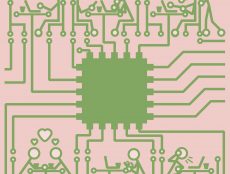
Articles
Editor’s Picks
The 2020s: Nascent Technologies that Show Promise in Education
By Henry Kronk
December 30, 2019
As the month, the year, and the decade come to a close, many have voice predictions about the year to come. The staff at eLearning Inside don’t pretend to own a crystal ball, let alone confidently make any predictions about the future. But over the course of our reporting, we have certainly encountered various technologies and their innovative uses that have yet to be used at large scales, but appear to demonstrate huge potential. We’ve described a few that show the most promise below.
Nascent Technologies in Education and EdTech: Internet Delivered Via TV Whitespace (UHF and VHF) Frequencies
This year, the non-profit EducationSuperHighway announced they had all but 100% bridged the digital divide in education. They had worked with schools, districts, states, internet service providers, and the federal government to ensure that just about every K-12 public school in the U.S. had high speed internet delivered at a minimum of 100 kbps.
While more work will always remain to increase capacity and repair and upgrade technology, it marks a major milestone in connecting everyone (who wishes to be connected) to the internet. Doing so provides increased access to opportunities relating to work, education, social life, and more. A growing number of leaders are beginning to view internet connection as a social justice issue.
It took massive coordinated efforts to bridge the digital divide in the U.S. But in other countries and rural regions, that possibility is still a long ways off.
Dr. Rouzbeh Yassini, executive director of the Broadband Center for Excellence (BCoE) at the University of New Hampshire (UNH), and the man considered to be the father of the cable modem, believes that there is a way to connect the rest of the world to high speed internet without laying any more cable.
His answer is internet delivered via television whitespace.
“We got the first 4 billion people connected in the world using dock system cable modems and what we call broadband,” Dr. Yassini said. “The other 4 billion, at much lower cost, will be connected by TVWS. My goal before I die is to see the entire population of the earth, the entire 8 billion, connected, on the grid, and able to do internet activity safe and secure and so on. TVWS is the lowest possible cost denominator and the fastest way we can get the global community connected.”
Read the rest of our interview here.
Smart Voice Activated/Voice Assistant Devices
Many education stakeholders have begun to raise alarms about the effect that screens have on learners. Others simply want a more natural alternative device that doesn’t require visual focus or repetitive hand movements.
Some have seen smart voice assistants—Siri, Alexa, Cortana, Google Home—as the answer.
One in particular, Amazon’s Alexa deployed via Echo Dots, has been employed widely for education initiatives.
The company has partnered with Arizona State University to test their uses out in dorms and to organize hackathons for students themselves to explore their uses.
Bamboo Learning, a Seattle startup that develops Alexa skills for educational uses, recently accepted $1.4 million in seed funding.
Smart voice assistant technology, however, does not come without its issues, especially for underage learners.
Two federal lawsuits were filed against Amazon this summer alleging the company illegally recorded the voice data of minors without obtaining their consent.
If used in primary or secondary schools, the devices would be subject to further regulation. The lawsuits remain pending.
Blockchain
Blockchain has certainly found its way into prediction pieces across industries for years. We’re including it here and now for two reasons: development companies are beginning to build more diverse edtech applications using the technology with a value proposition of securing data; and the technology is gaining more support and coordination from state and federal governments and bigger names in the private sector.
This latter point is especially important. The bipartisan Congressional Blockchain Congress launched in September 2016 with an initial membership of two: then-Rep. Jared Polis (D-Colorado) and then-Rep. Mick Mulvaney (R-South Carolina). In the current Congress, membership has swelled to 17 with almost equal representation from both parties.
On January 31st of the New Year, the caucus, along with the Government Blockchain Association, will bring together 450 stakeholders representing the government, private sector, and academia for an event to further push collaboration and development of the technology. Many have lobbied for granting blockchain developed lessened regulation. As more support snowballs, there will likely be increased benefits for edtech downstream.
Featured Image: Stock Photography, Unsplash.









No Comments